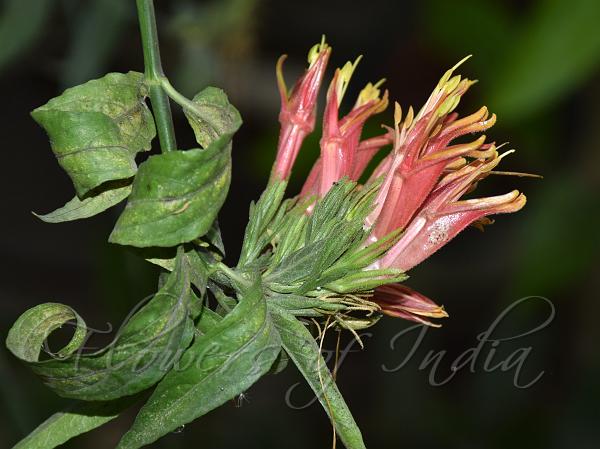|
| Sabah Snake Grass |
|

|

| File size | 559921 |
| Original date | 4/3/15 4:41 PM |
| Resolution | 2048 x 1536 |
| Flash | Flash fired, return detected |
| Focal length | 100.0mm |
| Exposure time | 1/200s |
| Aperture | 10.0 |
| Focus Distance | |
| Metering Mode | Center weighted average |
| Camera make | NIKON CORPORATION |
| Camera model | NIKON D5300 |
| Sensor type | OneChipColorArea |
|
|
|
|
Photo: |
Botanical name: Clinacanthus nutans Family: Acanthaceae (Acanthus family)
Synonyms: Justicia nutans, Clinacanthus siamensis
Synonyms: Justicia nutans, Clinacanthus siamensis
Sabah Snake Grass is a small shrub usually found in
South East Asia, particularly in Malaysia and Thailand. Leaves are in
paired opposite arrangement, narrowly elliptic-oblong in shape and pale
green in color. It has small, soft, thin and slightly curved stem that
resembles the curve of an elephant’s trunk. Thus, it is also known as
Daun Belalai Gajah (elephant’s trunk) in Malay. The flowers are borne
in dense cymes at the top of branches, covered with 5-alpha cymules,
and combined into a large lax, leafy panicle. Calyx is 0.9-1.3 cm long,
sepals linear, outside gland-tipped hairy, tip pointed. Flower are dull
red with a green base, 3-4.2 cm, gland-tipped hairy on the outside,
hairless inside except for a ring of trichomes about 5 mm above base;
tube basally cylindric for about 5 mm and about 3 mm wide then
gradually widened to about 6 mm at mouth; lower lip 1-2 Χ about 1 cm,
with yellow streaks; upper lip triangular, 1-2 Χ about 0.5 cm, erect,
tip notched; petals ovate, 3-5 Χ 1-2 mm. Stamens protrude from mouth of
flower; filaments 1-1.5 cm, hairless, style 3-3.7 cm, base sparsely
velvet-hairy. The ovary is compressed into two cell and each cell
having two ovules in each cell. Capsule is oblong, basally contracted
into a short, solid stalk 4-seeded. Seeds are 2 mm in diameter 14 . The
cylindrical stem turns into yellow when it becomes dry The leaves of
Sabah Snake Grass can be consumed as raw vegetable or mixed with other
juices. The dried leaves of this plant can be soaked in hot water and
served as tea.
Medicinal uses: is widely known in
traditional medicine in Malaysia and Thailand due to its medicinal
properties in treating skin rashes, insect and snake bites, and skin
lesions caused by virus. It has also been used to treat diabetes
mellitus, fever, diarrhea and dysuria. Recently, there are many C.
nutans products available in market in the form of herbal tea,
capsules, tablets and concentrated plant extracts.
is widely known in
traditional medicine in Malaysia and Thailand due to its medicinal
properties in treating skin rashes, insect and snake bites, and skin
lesions caused by virus. It has also been used to treat diabetes
mellitus, fever, diarrhea and dysuria. Recently, there are many C.
nutans products available in market in the form of herbal tea,
capsules, tablets and concentrated plant extracts.
Medicinal uses:
 is widely known in
traditional medicine in Malaysia and Thailand due to its medicinal
properties in treating skin rashes, insect and snake bites, and skin
lesions caused by virus. It has also been used to treat diabetes
mellitus, fever, diarrhea and dysuria. Recently, there are many C.
nutans products available in market in the form of herbal tea,
capsules, tablets and concentrated plant extracts.
is widely known in
traditional medicine in Malaysia and Thailand due to its medicinal
properties in treating skin rashes, insect and snake bites, and skin
lesions caused by virus. It has also been used to treat diabetes
mellitus, fever, diarrhea and dysuria. Recently, there are many C.
nutans products available in market in the form of herbal tea,
capsules, tablets and concentrated plant extracts. | Identification credit: Amber Srivastava | Photographed at Sant Asharamji Ashram, Lucknow. |
• Is this flower misidentified? If yes,